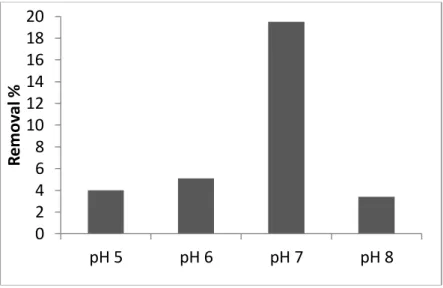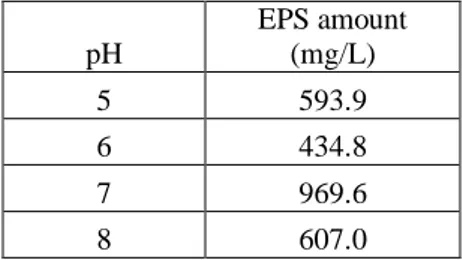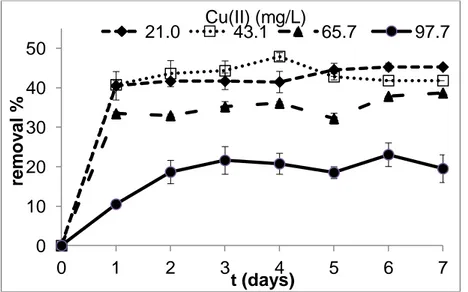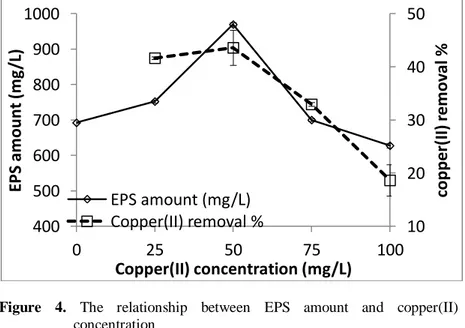A STUDY ON EPS PRODUCTION BY a MICROORGANISM EXPOSED TO COPPER(II) IONS
NUR KOÇBERBER KILIÇ
Department of Biology, Faculty of Science, Ankara University, 06100, Beşevler, Ankara, Turkey
e-mail address: nrkilic@ankara.edu.tr
(Received February 14, 2011; Accepted April 15, 2011)
ABSTRACT
The microorganism used in this study isolated from industrial wastewaters including heavy metals. The microorganism was tested with regard to its copper(II) removal and EPS production at different pH levels and copper(II) concentrations. The optimum pH was 7 for both copper(II) removal and EPS production of the microorganism. The highest copper(II) removal values were obtained as 45.3% at 21.0 mg/L copper(II) and 41.8% at 43.1 mg/L copper(II) concentrations after incubation for 7 days, respectively. On the other hand, the highest EPS production of the bacteria was 969.6 mg/L in media with nearly 50 mg/L copper(II) concentration. The increasing EPS production of the microorganism in media with copper(II) proved that copper(II) was attached to the EPS produced.
KEYWORDS: EPS, bacteria, copper(II), wastewater INTRODUCTION
Aquatic pollution by toxic substances as heavy metal ions has been a major concern over the past decade according to the increased industrial production. There are number of industries such as textile, paper and pulp, printing, iron-steel, petroleum, paint, chemicals and pharmaceutics, metal-cleaning, plating, and metal-processing have been releasing these highly toxic pollutants to the environment1. Wastewaters can include heavy metals, aromatic hydrocarbons, and also phenolic substances. Of these; copper(II) is known as one of the most toxic heavy metal to living organisms at high
concentrations. Heavy metal or phenolic substances including wastewaters are very toxic to all living organisms and required to be treated. There are several treatment methods that have been used to remove heavy metal ions from wastewaters such as coagulation, ozonation, oxidation, Fenton’s reagent, NaOCl, chemical precipitation, coagulation, ion exchange, membrane filtration, adsorption and evaporation 2-3. However, the technologies used in treatment of wastewaters are not found economical and often just not feasible.
On the other hand, some microorganisms are reported as they can remove copper(II) from copper(II) including wastewaters 4. Bioremoval of copper(II) ions might be related to mechanisms such as binding of the heavy metal to cell surfaces, reduction of it to a less toxic form, or translocation of the ions into the cell 5. Removal of copper(II) might be occurred via attaching EPS which is a biologic pathway.
EPSs play an important role in the aggregation of bacterial cells in flocs, stabilization of a biofilm structure, and formation of a protective barrier. Related to its properties, EPS also has roles like protecting the microorganism from desiccation, osmotic stress, low temperature, and biosorption of toxic pollutants from industrial wastewaters 6, 7. EPS is mostly known as a toxic metal chelator 8, 9.
In the present study, the EPS production by a microorganism isolated from copper(II) including wastewaters was investigated. In addition, the environmental conditions (pH, copper(II) concentration, and incubation period) affecting EPS production were also examined to determine the optimal EPS production by the bacteria tested in the study. The major objective was to investigate the correlation between EPS production and copper(II) removal by the bacteria.
MATERIALS
Isolation of microorganism
Wastewater samples were obtained from industrial effluent (İzmit, Turkey). Samples of the wastewaters (0.1 ml aliquot) were used to inoculate nutrient agar including copper(II) (100 mg L-1) After incubation period single colonies on the plate were purified and transferred to agar slants. The pure
cultures were kept on at 4 °C and transferred every 3 months. For the selection of high copper(II) removing culture, the pure cultures were incubated into 100 ml of the molasses media (including molasses solution: nearly equivalent to 10 g L-1 sucrose, 1.0 g L-1 NH4SO4, 0.5 g L-1 KH2PO4) having 100 mg L-1 copper(II) in a 250 ml Erlenmeyer flasks at 30 °C on a rotary shaker at 100 rpm for 5 days at pH 7.
Heavy metal solution
Copper(II) stock solution obtained from Merck in anhydrous copper sulfate form to a final concentration of 10 g L-1 of copper(II). Appropriate volumes of the stock heavy metal solution were added to media.
METHODS EPS production
To determinate EPS amount, culture was inoculated onto Nutrient Broth No 1 media (Fluka-BioChemika) agar mix in petri dishes. The composition of the media was 15 g of peptone, 3 g of yeast extract, 6 g of sodium chloride, 1 g of glucose, and 15 g of agar in 1 L.
To determine the optimum pH for the highest EPS production, the pH of the media including 50 mg/L copper(II) was adjusted to 5, 6, 7, and 8 with 0.1 M NaOH and 0.1 M HCI. The petri dishes were prepared in three replicates and incubated for 48 h at 30 °C (Memmert GmbH and Co. KG Germany). Copper(II) removal by microorganism
To determine the optimum pH for the highest copper(II) removal, the pH of the molasses media including 50 mg/L copper(II) was adjusted to 5, 6, 7, and 8 with 0.1M NaOH and 0.1M HCI.
To determine copper(II) removal in liquid media by the bacteria, culture was grown in 100 mL of molasses medium (pH 7, 30 °C) in 250 mL Erlenmeyer flasks and incubated on a rotary shaker (New Brunswick Scientific Innova 4230, USA) at 100 rpm. Microorganism was grown in
media with increasing copper(II) concentrations as 21.0, 43.1, 65.7, and 97.7 mg/L.
EPS extraction: The EPS isolation was carried out as described by Cérantola et al., (2000) with minor modifications 10
. To isolate EPS from the cultures, colonies were picked up from the agar surface with a glass rod and suspended in an osmolar solution. The suspensions were boiled at 100 °C for 15 min. After cooling, trichloroacetic acid (TCA) was added to a final concentration of 4% (w/v) to precipitate proteins and they were centrifuged at 10,000 xg for 30 min at 4 °C. The supernatant was removed and mixed with cold ethanol. The suspension was centrifuged at 10,000 xg for 30 min at 4 °C. The extraction was repeated once more; the pellets were removed and dissolved in distilled water. The sugar content of EPS was determined using phenol-H2SO4 reagent, glucose solutions were used as calibration standards 11.
Residual copper(II) analysis: The residual copper(II) concentration of the broth was measured spectrophotometrically at 460 nm using sodium diethyl dithiocarbamate as the complexing agent for copper(II) 12. Cell free molasses medium was used as the blank. The percentage removal of copper(II) was calculated from the equation:
100
%
Co
Cf
Co
removal
In the equation, C0 and Cf are the initial and final concentrations (mg /L),
respectively. Absorbance measurements and centrifugation were performed using a Shimadzu UV 2001 model spectrophotometer (Japan) and Hettich EBA12 model centrifuge (Germany).
Statistical analysis
The experiments were set up in a completely randomized design with three replicates. The data were subjected to analysis of variance using Minitab 14 and significant differences among treatment means were compared by descriptive statistics (±SE).
RESULTS AND DISCUSSION
Effect of pH onto copper(II) removal and EPS production by the microorganism
The effect of the pH value of the media (pH 5, 6, 7, and 8) on copper(II) removal was determined in molasses including nearly 50 mg/L copper(II) after incubation for 7 days (Fig.1). According to the data obtained, the removal of copper(II) by the microorganism was very low yields at pH 5 and 6 and the removal percentages were 4% and 5.1%, respectively. However, at pH 7, microorganism removed the applied heavy metal with the highest yield as 19.5%. The removal process was affected negatively from the increase of the pH level and yield decreased at pH 8 from 19.5% to 3.4%. At the end of these series of the experiments, the maximum removal of copper(II) was determined at pH 7, therefore further experiments were done at pH 7 level.
Figure 1. Effect of pH on copper(II) removal by the microorganism (incubation period 2 d, initial copper(II) concentration: 50 mg/L)
0
2
4
6
8
10
12
14
16
18
20
pH 5
pH 6
pH 7
pH 8
R
em
ov
al
%
The effect different pH of the media (pH 5, 6, 7, and 8) on EPS production of the microorganism was also determined in nutrient agar media with including nearly 50 mg/L copper(II) (Table 1). Similarly to the copper(II) removal experiments, the maximum EPS amount was also determined at pH 7 level (969.6 mg/L). The microorganism produced nearly 500 mg/L EPS at pH 5 and 6. On the other hand, the microorganism had an EPS production level as 607.0 mg/L at pH 8. The experiments were done in nutrient agar media with a pH level as at pH 7 according to the data obtained from these trials.
Table 1. Effect of pH on EPS production by the microorganism (incubation period 2 d, initial copper(II) concentration: 50 mg/L)
Similar results were obtained by Bhaskar and Bhosle (2006) 13. In that study, investigators showed that Marinocabter species removed copper(II) ions and produced EPS at neutral pH level as it was same in the present study.
Effect of copper(II) concentration onto copper(II) removal and EPS production by the microorganism
To investigate the copper(II) concentration on removal of copper(II) by the microorganism used in the study, different concentrations of copper (21.0-97.7 mg/L) including molasses media (pH 7) was used. As shown in Fig.2, the bacterium removed the heavy metal with a high capacity at the beginning of the incubation period. In addition, with an increase in copper(II) concentration, the removal yields decreased. The maximum copper(II) removal was determined at 21.0 mg/L and 43.1 mg/L copper(II)
pH EPS amount (mg/L) 5 593.9 6 434.8 7 969.6 8 607.0
concentrations. Under these heavy metal concentrations the bacterium removed the applied pollutant with similar removal percentages. The highest removal yields were 45.3% and 47.9% for 21.0 mg/L and 43.1 mg/L copper(II) concentrations, respectively. Under 65.7 mg/L copper(II) concentration, the maximum removal yield was determined as 38.7% after incubation for 7 days. The microorganism was affected negatively from an increment of the pollutant and removal yield decreased under 97.7 mg/L copper(II) concentration.
Figure 2. Effect of initial copper(II) concentration on copper(II) removal during the incubation period
The effect of different copper(II) concentrations on EPS production of the bacterium was shown in Fig. 3. According to the results obtained, the microorganism produced much more EPS in media with copper(II) compare to media without copper(II). In media without copper(II) EPS amount was 692.2 mg/L, while with an addition of copper(II) as 25 mg/L, the amount was 752.2 mg/L. The increment of copper(II) affected EPS production and
0
10
20
30
40
50
0
1
2
3
4
5
6
7
re
m
o
v
a
l
%
t (days)
21.0
Cu(II) (mg/L)
43.1
65.7
97.7
microorganism produced the maximum EPS in media with 50 mg/L copper(II) with a yield as 969.6 mg/L. The media with 75.0 mg/L of copper(II), the bacterium was affected negatively from the pollutant, but the EPS production (700.0 mg/L) was still higher than EPS amount in media without heavy metal (692.2 mg/L). In media with 100.0 mg/L copper(II) the bacterium had an EPS production as 627.5 mg/L.
Figure 3. Effect of initial copper(II) concentration on EPS production (incubation period 2 d)
According to the study previously done, P. aeruginosa exposed to Cu(II) ions and in response to the heavy metal, bacteria had higher amount of total EPS (9.51 mg/g) than in the absence of Cu(II) (3.15 mg/g) at 100 mg/L Cu(II) concentration 14. Another study was carried out by Kılıç and Dönmez (2008) in media with another toxic heavy metal as Cr(VI). In that study, authors showed that P. aeruginosa, Micrococcus sp., and Ochrobactrum sp. had more EPS amount in media with Cr(VI) than in media with no Cr(VI) 15 . 0 100 200 300 400 500 600 700 800 900 1000 0 25 50 75 100 EP S p ro d u ct io n (m g/L ) Cu(II) concentration (mg/L)
In the present study, it was also shown that when the microorganism was exposed to the heavy metal as copper(II), it produced much more EPS to cope with heavy metal toxicity.
The relationship between copper(II) removal and EPS production
To determine the relationship between copper(II) removal and EPS production by the bacterium, the microorganism was inoculated in molasses media for copper(II) removal experiments and in nutrient agar media for EPS production trials. It was seen from Fig.4, the bacterium removed copper(II) with a yield of 41.7% at nearly 25 mg/L copper(II) after incubation for 2 days. Under this condition, the bacterium had an EPS yield as 752.2 mg/L. In media with approximately 50 mg/L copper(II) concentration, the bacterium had the highest heavy metal removal as 43.6% and EPS amount as 969.6 mg/L after 2 days. Above 50 mg/L copper(II) concentration both removal of copper(II) and EPS amount decreased.
Figure 4. The relationship between EPS amount and copper(II) concentration
10
20
30
40
50
400
500
600
700
800
900
1000
0
25
50
75
100
co
p
p
e
r(
II
) r
e
m
ov
al
%
EP
S
am
ou
n
t
(m
g/
L)
Copper(II) concentration (mg/L)
EPS amount (mg/L)
Copper(II) removal %
The data obtained from these trials indicated that copper(II) removal is connected to the EPS production by the bacterium. The relationship between copper(II) removal and EPS production is correlated to the mechanism including the binding of the heavy metal to the EPS produced by the microorganism. Thus, copper(II) was attached to the EPS and removed by the bacterium by this pathway.
Acknowledgements
Financial support was provided by Ankara University Research Found. ÖZET:
Çalışmada kullanılan mikroorganizma ağır metal içeren endüstriyel atıksulardan izole edilmiştir. Mikroorganizmanın farklı pH’larda ve bakır(II) konsantrasyonlarındaki bakır(II) giderimi ve EPS üretimi belirlenmiştir. Mikroorganizmanın bakır(II) giderimi ve EPS üretimi için optimum pH’I 7 olarak bulunmuştur. Yedi gün inkübasyon periyodu sonucunda, en yüksek bakır(II) giderimi 21.0 mg/L bakır(II) konsantrasyonunda %45.3 ve 43.1 bakır(II) konsantrasyonunda %41.8 olarak elde edilmiştir. Diğer taraftan, yaklaşık 50 mg/L bakır(II) içeren besiyerinde en yüksek EPS üretimi 969.6 mg/L’dir. Bakır(II) içeren ortamda mikroorganizma tarafından üretilen EPS’nin artması bakır(II)’nin EPS’ye bağlandığını kanıtlamaktadır.
REFERENCES .
[1] Aksu, Z., 2005. Application of biosorption for the removal of organic pollutants: a review, Process Biochem, 40: 997-1026.
[2] Robinson, T., McMullan, G., Marchant, R., Nigam, P., 2001. Remediation of dyes in textile effluent: a critical review on current treatment technologies with a proposed alternative, Biores Technol, 77: 247-255.
[3] Kurniawan, T.A., Chan, G.Y.S., Lo, W-H., Babel, S., 2006. Physico– chemical treatment techniques for wastewater laden with heavy metals, Chem Eng J, 118: 83-98.
[4] Dönmez, G., Aksu Z., 1999. The effect of copper(II) ions on the growth and bioaccumulation properties of some yeasts, Process Biochem, 35(1-2):135-142.
[5] Bruins, M.R., Kapil, S., Oehme, F.W., 2000. Microbial resistance to metals in the environment, Ecotoxicol Environ Safety, 45:198-207.
[6] Zhang, D., Wang, J., Pan, X., 2006. Cadmium sorption by EPSs produced by anaerobic sludge under sulfate-reducing conditions, J Hazard Mater, B138: 589–593.
[7] Hugenholtz, J., Looijesteijin, E., Starrenburg, M., Dijkema, C., 2000. Analysis of sugar metabolism in an EPS producing Lactococcus lactis by 31
P NMR. J Biotechnol, 77: 17–23.
[8] Velasco, S., Arsköld, E., Paese, M., Grage, H., Irastorza, A., Radström, P., van Niel, E.W.J., 2006. Environmental factors influencing growth of and exopolysaccharide formation by Pedicoccus parvulus 2.6. Int J Food Microbiol, 111:252–258.
[9] Ozdemir, G., Ozturk, T., Ceyhan, N., Isler, R., Cosar, T., 2003. Heavy metal biosorption by biomass of Ochrobactrum antropi producing exopolysaccharide in activated sludge, Biores Technol, 90: 71–74.
[10] Cérantola, S., Bounery, J., Segonds, C., Marty, N., Montrozie, H., Exopolysaccharide production by mucoid and non-mucoid strains of
Burkholderia cepacia, FEMS Microbiol Lett, 185 :243–246.
[11] Dubois, M., Gilles, K.A., Hamilton, J.K., Rebers, P.A., Smith, F., Colorimetric method for determination of sugars and related substances, Anal Chem 28: 350–356.
[12] Snell, F.D., Snell, C.T. (third ed.), (1959). Colorimetric Methods of Analysis 2, Van Nostrand, Canada.
[13] Bhaskar, P.V., Bhosle, N.B., 2006. Bacterial extracellular polymeric substance (EPS): A carrier of heavy metals in the marine food-chain, Environ Int, 32:191-198.
[14] Kazy, S.K., Sar, P., Singh, S.P., Sen, A.K., D’Souza, S.F., 2002. Extracellular polysacharides of a copper-sensitive and a copper-resistant
Pseudomonas aeruginosa strain: synthesis, chemical nature and copper
binding, World J. Microbiol Biotechnol, 18:583–588.
[15] Kılıç, N.K., Dönmez, G., 2008. Environmental conditions affecting exopolysaccharide production by Pseudomonas aeruginosa, Micrococcus sp., and Ochrobactrum sp., J Hazard Mater, 154: (1-3):1019-1024.



